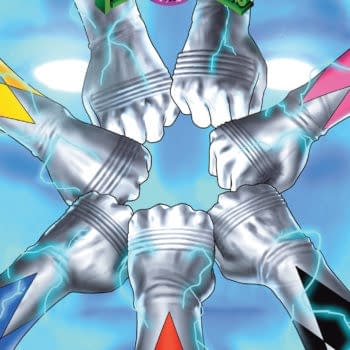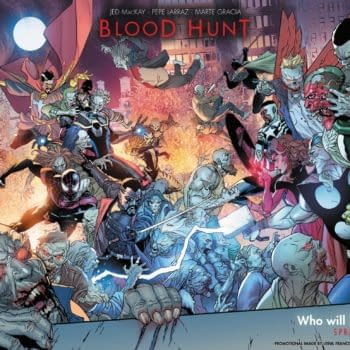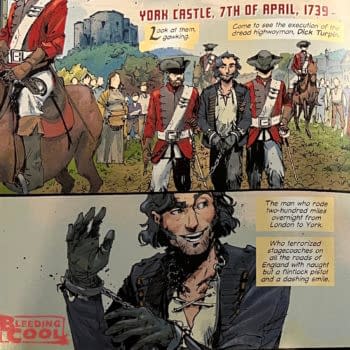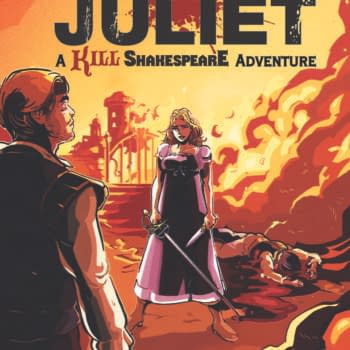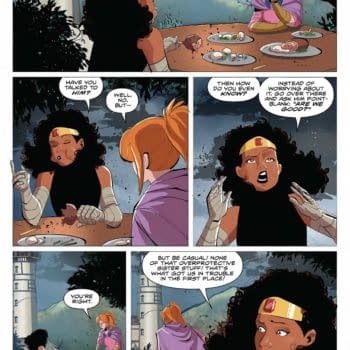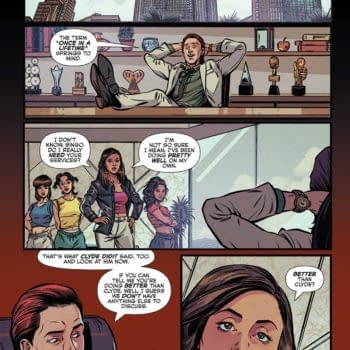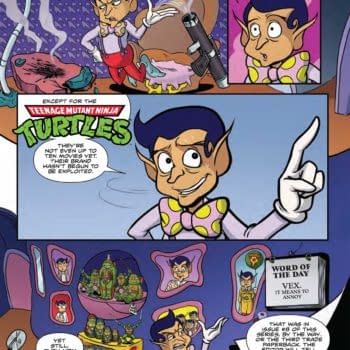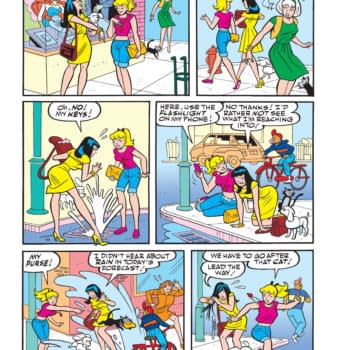Posted in: Comics | Tagged: american vampire, anthology, Comics, dc, scott snyder, vertigo
Telling The Bigger Story In American Vampire Anthology

What if you could throw out a net and gather the best fan fiction in the world for a series you were working on? Would you really want to do that? Could you do that without feeling that the fan fiction might rise to the level of the original and somehow undermine your achievements? The motivation behind such a move would have to be either an obsessive love for the universe you've created, to the point of wanting to make it bigger and better in ways that aren't necessarily in your purview, or an assumption that high-quality fan fiction is part of the original creation, the more so the more widely read it is and the more it enters into public consciousness. But why not both? Both could certainly be true of American Vampire Anthology.
The decision to solicit and invite professionals in comics to contribute to an anthology, each writing and drawing a story that they feel fits into the American Vampire universe might seem like an appropriate "hoorah" to a series that had announced its cancellation, but in the wake of the announcement that the series is returning later this year (enhanced by the one-shot Long Road to Hell featuring Travis Kidd's exploits), the place of the anthology becomes even more interesting. It becomes a sudden explosion of creativity to fill the hiatus with a kind of day-dreamy recap of mythology and possibility for the American Vampire series. The book-ended stories written and drawn by series creators Scott Snyder and Rafael Albuquerque are simple and artful at pointing out the place of "stories" through the words of Skinner Street. And whatever practical function the anthology may serve to keep readers hungry for more, or give them closure on the previous epoch of the series (spanning 5 collected volumes), the collection also serves as a genuine contribution to the history and scope of the world that Snyder and Albuquerque have created, both in artwork and in narrative.
[* Mild spoilers for the Anthology below]
The two-part Snyder/Albuquerque story that wraps around the collection, which includes 8 other stories, is called "The Man Comes Around", an ambiguous title that could suggest Sweet's growing realization of the ways in which his past will govern his future, as he "comes around" to his own renewed involvement in his fate. What he says hints to the reader about the purpose of the anthology: "All the stories told, they're just a fraction of it…of the bigger thing. Because there is a bigger story happening here. Something we're all a part of…". He goes on to say that when it "comes" for him, "That's when the wildest stories of all will be born". That is not a bad marketing device for the hopefully returning series, emphasizing that the creators intend to raise things to a new and "wilder" level than ever before. But more than that, it honors the role of story in the series. It is a series that is story-obsessed from episodic tale-telling to historically-sweeping arcs, and that's why the anthology works, because the series was already one which embraced its inner accordion-file structure, and recognized that to tell history, you have to deal in fragments and also in collage to create the bigger picture. This is perfect building ground for wide-ranging contributions from many creative voices.
What we have in the anthology are 8 other stories that range in time-period and location, picking up threads and making connections to established events and characters. The stories build helpful bridges but also stake out new territory on the edges of the known for readers. From a 16th century tale of "classic vampires" terrorizing a Native American community, and their adaptive handling of the situation, to 19th century pioneer vignettes, several stories embracing the 1920's focus of the series, and a couple launching readers forward into the 1940's, the anthology becomes kaleidoscopic. Reading it in one sitting encourages you to look for common patterns and touchstones, not just in characters but in ideas. Meanwhile you come away with a sense of having seen a fairly massive sweep of history that, rather than confining readers to a sense of the known and making them feel secure about it, impresses upon them the certainty that there is more, so much more, that could, in fact, still be told.
Suggesting that there's more to be told is a product, partly, of how short many of the anthology stories are. Like short stories, these short comics create an impression, and then abruptly leave you to consider what you just saw for far longer than it actually took to read the story. But I mentioned pro fan fiction, and here we have the double-barrel component of both writers and artists who want to get a grip on a world they feel is creatively inspiring. These team-ups are well-matched and actually very different in their contributions.
Jason Aaron and Declan Shalvey give such a sense of historical reality and human desperation that "Lost Colony" creates an epic feel in only a few pages. It puts the human in American Vampire in an unexpected way, but also reminds us what monsters can be, human or otherwise.
Rafael Albuquerque and Ivo Milazzo present such a radical twist in "Bleeding Kansas", particularly in artwork, for the series that they challenge many of your assumptions about the up close and personal nature of reading the comic by forcing you to step back and see characters as a product of a place and time.
"Canadian Vampire", by Jeff Lemire and Ray Fawkes is one of the most disturbing and strangely visionary pieces that may have ever graced the series mainly through its simplicity and light-eroded images and intense pacing. Whether it feels like a dream or a nightmare, it remains seared on your memory after reading it via its haunting, if tragic, gracefulness.
"Greed", with story and art by Becky Cloonan, jumps into 1920's film homage by explaining how Sweet ends up in Hollywood and plays to some of Cloonan's greatest strengths in etching out dominating figures (here Sweet) in an equally dominating landscape (here Death Valley). There's also the subtle, even humorous effect of comparing the way that people "play" heroes or villains in films and how they interact in the "real" world of the story, rendering Sweet larger than life.
Confirming a building sense of menace and darker undertones in the anthology, Francesco Francavilla provides story and art on "The Producers" where Hollywood stardom comes at a price some are more than willing to pay. Many of the creators in the anthology create a metaphorical parallel between predatory aspects of human society and vampirism, and here the film-poster spreads and cinematic close-ups make the drama of those human choices unforgettable.
You won't be surprised that "Essence of Life" by Gail Simone and Tula Lotay is one of the hardest hitting stories in the collection, and as such is well-placed to build chronologically as the stories branch forward in time. In only 8 pages Simone and Lotay manage to create a tableau of victimhood with remarkable psychological depth and arresting visual impact, a commentary not just on predators but on the nature of revenge.
"Last Night" by Gabriel Ba and Fabio Moon, opens a welcome door onto 1940's New York, and reminds us that there's a carnivalesque aspect to a history-jumping series, but it's a carnival rendered unsafe through its foundation in horror. It's a brief masterpiece of mood and shock-value, and like many of the pieces in the collection, is so beautifully rendered that you're reminded of just how much these pros have committed to their roles as extreme fans.
Greg Rucka and JP Leon step up to tell an intense episode in the life of Sweet in "Portland 1940", before the anthology rounds off with the Snyder/Albuquerque return. Little details from Sweet's history are picked up, examined, and more neatly arranged amid a rain of violence, shocking historicity, and a mix of lurid and subdued colors. Leon's artwork, particularly, makes us believe in 1940's Portland's reality, something that could, in fact, be more difficult than making us believe a man can fly.
American Vampire Anthology is as if Snyder and Albuquerque allowed each of their friends, in turn, to take their car on a road trip through varying terrain and extending a no-holds barred attitude about how fast they might drive, what kinds of passengers they might allow to tag along, and in what condition they might return it. To do that takes an enormous amount of confidence that the vehicle can handle that kind of treatment, but also an underlying and motivating desire that their friends have a memorable trip. What we get from this strange pact are all the snap-shots, the gritty and the luminous, and also a renewed awareness of just what American Vampire can do. It's a win for fans and a win for invigorating the upcoming series. The series may be getting "bigger" as Sweet predicts here, but it has already passed that milepost in the hands of its pro-fans.
Hannah Means-Shannon senior New York Correspondent at Bleeding Cool, writes and blogs about comics for TRIP CITY and Sequart.org, and is currently working on books about Neil Gaiman and Alan Moore for Sequart. She is @hannahmenzies on Twitter and hannahmenziesblog on WordPress. Find her bio here.









